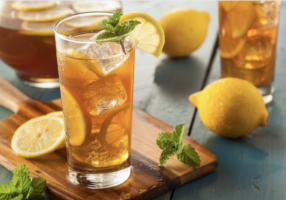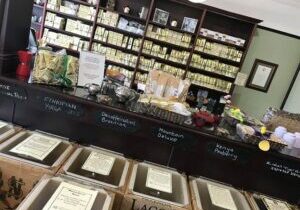I was speaking to a friend recently and the topic of cold teas came up. It’s summer, and it’s understandable that some people choose to put down the hot drinks – especially during heatwaves like we’ve experienced this year!
That friend said how they’d tried pouring their hot brewed, branded black tea over ice, adding a slice of lemon, and trying an ‘iced tea’. They were also shocked when the result was a bitter, stale tasting cup of disappointment.
But that isn’t how to enjoy cold teas.
I thought I’d use the opportunity to put together my thoughts and tips on a growing trend – cold brew tea.
The benefits of cold brew
It’s simple – Because there’s no heat required at any point in the process, it’s perfect for summer. Picnics, camping, even just keeping the unnecessary heat in the kitchen to a minimum!
It’s so refreshing – During the summer months, some people find that the thought of a hot, steaming cuppa is too much to deal with, but miss their favourite hot drinks. Iced coffee offers half of the solution – I’d say that cold brew tea could be the other half.
Fewer tannins than hot brew tea – Tannins are a type of polyphenol, an antioxidant compound that gives the astringent taste to tea. It’s therefore naturally smoother and sweeter, making it easier to kick the added sugar if you’re one of many going for that beach body at this time of year.
It’s hydrating – If you’re looking for a way to drink more water but enjoy something with a little more flavour, cold brew could definitely be the answer.
Get creative – Cold brew teas offer an opportunity to find the perfect drink combination for you. Play with different strengths, steeping times, teas, infusions, garnishes… Go experiment.
Get boozy – Should you want to spice it up for the weekend, I have known people to use spirits (particularly gins) instead of water when brewing, to create a delicately infused basis for a cocktail or spirit mixer combo!
What you’ll need to cold brew tea
At the very minimum, you will require:
- Tea (or herbal infusion)
- Strainer
- Pitcher (or any container to actually brew in)
- Teaspoon
- Glasses
- Refrigerator
One thing to note – I’d recommend a glass container in which to brew. Plastics and particularly metals can impart unwanted tastes on the end result.
The optional extras are where you can go really crazy. Ice, fruit, herbs, sweeteners, alcohol… Whatever you think will make a pleasant addition, try it.
Something else to note here – if you do wish to use a sweetener, I’d recommend going for a simple sugar syrup or honey. Liquid sweeteners will incorporate far easier than adding sugar. Or you could add additional fruit for a more natural sweetness!
How to cold brew
It’s essentially three steps, although I’ll go into more detail below.
- Put your tea into a container with water
- Pop the container into the fridge overnight (or 8 hours). This can be left longer – I’ve known people to brew for 48 hours and it not be ‘too long’
- Strain and serve
Now, that’s clearly a very simple version. So, a few things to bear in mind…
Quality is king. The quality of tea that you use will have a huge effect on the quality of the end result. Loose leaf tea will infuse better than that in a tea bag and is often of better quality. If you do use teabags, you’re best to empty the contents of the bag into the container to brew, then strain. Also consider your water – using filtered water may have a huge effect on the taste of the end product, particularly depending on the harshness of the water in your area.
Fruit. If you’re adding fruit for aesthetic purposes only, then adding it to the glass when you serve the drink is fine. If you’re adding it for flavour, however, it should be added at stage one. It should also be sliced as opposed to being whole or in wedges for maximum flavour. Fun tip – strawberries can turn the brew a lovely pink shade after a day of infusing.
Quantities and strength. The general rule of thumb is that for a standard strength, one teaspoon of tea per cup of water (or 12g of tea per litre) is plenty. This does of course depend on your own preference as well as the quality of the tea. Experiment with steeping times and ratios to get it right for you.
Types of tea to consider
Any tea or herbal infusion can be used. None should be dismissed – remember it’s all down to personal taste. I’ve given an overview of my thoughts on a few types of tea when it comes to cold brew.
Black tea – It’s strong, possibly a little less refreshing due to having high levels of tannins compared to other teas that have been cold brewed. That said, it makes it a great basis for a very fruity cold brew tea – fruits can give the drink the sweetness that cold brew black tea naturally lacks.
White tea – A more aromatic and light option. Naturally very refreshing. Perhaps the opposite, in the fact that you may want to avoid too much fruit – the fruit could easily overpower the subtle flavours. Herbs can be a great option here instead.
Green tea – The fresh and ‘clean’ option. Also aromatic. There’s a huge variety of green teas available, many of which are already infused with other flavours. Avoid clashes in infusions by getting a standard, high quality green tea if you’re planning on adding your own flavour infusions.
Roasted oolong – Perhaps the middle-ground between green and black teas – green teas are unoxidised, black teas are fully oxidised, where oolongs are partially oxidised. Roasted oolongs offer a dark cold brew tea that is still crisp and clean with floral notes.
Herbal infusions – For a totally caffeine free option, any herbal infusion can be brewed in the same way. The possibilities with herbal infusions are endless. Everything from peppermint to elderflower to chamomile – and all of the optional extras you can infuse or garnish with, too.





